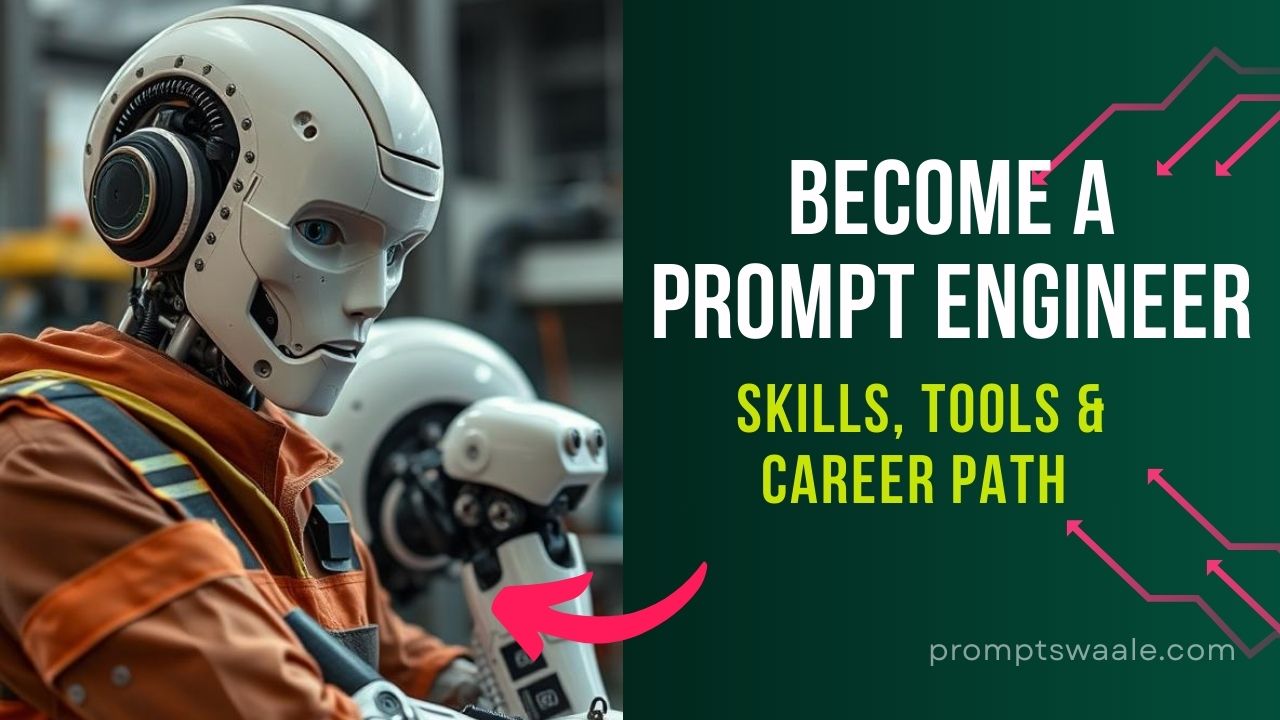Introduction
The job of a prompt engineer is to understand how to phrase, structure, and test prompts to achieve the desired outcomes. It’s not just about typing commands; it involves iteration, refinement, and a deep understanding of language and logic.
Prompt engineering is becoming a critical skill as more businesses integrate AI into their operations-from content creation and data analysis to customer service and automation.
What makes prompt engineering fascinating is its mix of creativity and logic. You must be able to think like a writer and a scientist. You need to know what the AI understands and how it interprets your words. This unique blend makes the profession both exciting and intellectually stimulating.
Understand the Basics of AI and Large Language Models (LLMs)

Before you can engineer prompts, you need to understand what you’re working with. Learn the fundamentals of artificial intelligence, particularly how large language models function. You don’t need a computer science degree to get started, but grasping key terms like “context window,” “tokens,” “zero–shot prompting,” and “temperature” will be extremely useful.
Free resources like YouTube videos, blog posts from OpenAI or Anthropic, and beginner courses on Coursera or DeepLearning.AI are great places to start.
Why Prompt Engineering is in High Demand?
AI tools are revolutionizing industries, but they’re only as effective as the prompts that drive them. Businesses need skilled individuals who can harness these tools efficiently-this is where prompt engineers come in. With the rapid adoption of large language models (LLMs), demand for prompt engineers has exploded.
Companies are discovering that poorly crafted prompts lead to low-quality outputs, inefficiencies, and missed opportunities. Prompt engineers solve this problem by refining how AI models are used, saving companies time and money. As a result, roles that didn’t even exist a few years ago are now commanding six-figure salaries and appearing in job boards across sectors.
Moreover, the role of a prompt engineer is constantly evolving. From tech giants like OpenAI to startups building on top of LLM APIs, everyone is looking for talent who can speak the “language of AI.” As more tools and platforms emerge, prompt engineering skills are becoming a must-have in the modern digital toolkit.
Understanding the Role of a Prompt Engineer
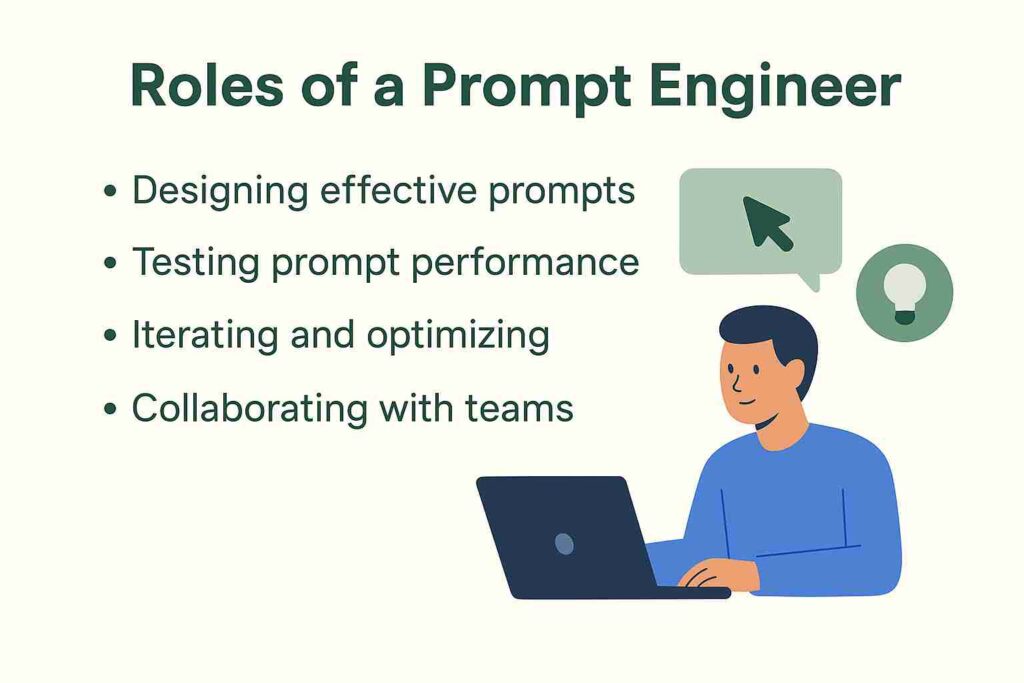
Core Responsibilities
Prompt engineers don’t just write prompts-they analyze, test, and iterate on them. Their day-to-day work involves:
- Designing clear and effective prompts for various tasks
- Testing prompts across different AI models and versions
- Analyzing output quality and refining instructions
- Collaborating with developers, data scientists, and UX teams
- Documenting prompt structures and outcomes for reproducibility
At a deeper level, prompt engineers must think strategically. They may need to design prompts that align with company goals, create workflows that integrate into automation systems, or troubleshoot unexpected model behavior. It’s not a static job-every prompt is a hypothesis, and every result is a test.
Their work also includes considering ethical implications. Ensuring that outputs are unbiased, safe, and in line with company values is critical. Prompt engineers often serve as the gatekeepers of AI output, shaping not just technical functionality but also brand voice and customer experience.
Who Hires Prompt Engineers?
A wide range of employers are actively seeking prompt engineers. Here’s a quick rundown:
- Tech companies: Giants like Google, Microsoft, and OpenAI want prompt experts to refine their AI products.
- Startups: Especially in AI-focused SaaS, healthcare, finance, and edtech.
- Marketing agencies: To create better ad copy, SEO content, and social media strategies using AI.
- Media companies: To help automate content creation and editorial processes.
- Consulting firms: Offering AI transformation services to clients.
- E-commerce and customer service platforms: To build efficient chatbot and virtual assistant prompts.

Even sectors like law, medicine, and education are hiring prompt engineers to improve research, documentation, and training materials.
Industries Benefiting from Prompt Engineering
Prompt engineering is cross-disciplinary. Here are some industries where it’s making waves:
- Healthcare: AI is helping summarize medical records, suggest treatments, and improve patient engagement.
- Legal: Automating legal research, summarizing case law, and drafting documents.
- Finance: Enhancing financial analysis, reporting, and customer service.
- Education: Powering intelligent tutoring systems, content generation, and personalized learning.
- Retail and E-commerce: AI-generated product descriptions, reviews, customer interactions.
Each of these sectors uses AI in different ways, but all depend on high-quality prompts to get meaningful output. That means more opportunities for prompt engineers to carve out a niche and specialize in a particular domain.
Essential Skills for Prompt Engineers
Strong Natural Language Understanding
At the heart of prompt engineering lies the ability to communicate clearly and effectively. To create impactful prompts, you need to deeply understand natural language-how it works, how it’s structured, and how it can be interpreted. This isn’t about just being fluent in English or any other language; it’s about mastering the nuances, tone, grammar, context, and semantics.
Prompt engineers must predict how an AI will respond to specific wordings. This requires more than just technical know-how; it takes linguistic intuition. For instance, rephrasing a question from “What happened in 1776?” to “Give a brief historical summary of events in 1776” might yield a more focused and informative response. These micro-adjustments can significantly enhance output.
Also, being multilingual or understanding how language translation affects prompts is a huge advantage. AI models often have varying fluency in different languages, and prompt engineers who can navigate this multilingual space are highly sought after.
Critical Thinking and Creativity
Prompt engineering is not just a technical skill-it’s a creative problem-solving challenge. You’ll constantly be asked to think on your feet, test new approaches, and refine ideas that didn’t work. Imagine trying to make an AI role-play as a customer service agent or create a poem that follows a specific rhyme scheme-you’ll need creative muscle and critical logic.
You’re essentially guiding an unpredictable, sometimes stubborn, digital brain. That means your job isn’t just about asking the right question, but about asking it in the most effective way. Critical thinking helps you reverse-engineer responses and figure out what went wrong and how to fix it.
Creativity is especially crucial when dealing with generative tasks like storytelling, content writing, or marketing copy. Here, prompts need to be structured in a way that inspires the AI to deliver exciting, high-quality outputs. The better your creative thinking, the more engaging your results.
Programming and Technical Knowledge
Although prompt engineering is often portrayed as non-technical, having programming knowledge gives you a massive edge. Basic scripting-usually in Python-is often required to automate tasks, run batch prompts, or integrate models into larger systems. You don’t need to be a software engineer, but understanding how APIs, JSON responses, and data structures work is important.
For example, using OpenAI’s API might involve looping through prompts with variations and saving the outputs for analysis. Understanding how to write these scripts allows you to scale your testing and improve efficiency.
Also, if you’re working alongside developers or data scientists, speaking their language helps. You’ll often be tasked with integrating prompts into products or dashboards, and basic tech literacy makes collaboration smoother and faster.
Familiarity with AI and Machine Learning Concepts
You don’t need to build neural networks from scratch, but knowing the basics of AI-like what a large language model is, how it was trained, and what its limitations are-is crucial. Prompt engineers often operate at the intersection of human language and machine logic. Understanding how models interpret and process input gives you better control over the results.
Key concepts to understand include:
- Temperature and top-p sampling (affecting randomness in output)
- Token limits and context windows
- Fine-tuning vs. few-shot prompting
- Model hallucinations and bias
The more you know about how the underlying tech works, the more precise and reliable your prompts will be. This makes you not just a prompt writer but a strategic thinker who knows how to use AI responsibly and effectively.
Tools and Technologies Used in Prompt Engineering

AI Platforms (e.g., OpenAI, Anthropic, Cohere)
Prompt engineers must be familiar with a variety of AI platforms and models. Each provider has its own quirks and capabilities. Here are some of the most widely used ones:
- OpenAI (ChatGPT, GPT-4): The most popular platform, used for everything from coding to copywriting.
- Anthropic (Claude): Known for its alignment and safety features, useful for enterprise-level deployments.
- Cohere: Offers flexible NLP capabilities and great multilingual support.
- Google Gemini: Ideal for integrating with Google’s suite of tools and search engines.
Learning how each model handles prompts differently can significantly impact your success. Some models respond better to short, direct queries; others handle long, multi-turn prompts more smoothly.
Prompt Design Tools and Sandboxes
Prompt engineers don’t just work in plain text editors. Many use sandboxes or playgrounds to experiment and test prompts in real time:
- OpenAI Playground: Offers temperature, max token, and frequency control.
- PromptPerfect: Optimizes prompts using automation and AI-generated suggestions.
- FlowGPT: A community-based tool for sharing and testing prompt ideas.
- Replit or Jupyter Notebooks: For running iterative prompt tests in Python scripts.
These tools allow you to fine-tune prompts, save your best versions, and analyze outputs. Over time, you’ll build your own toolkit of go-to platforms.
Code Repositories and Version Control (GitHub, GitLab)
Prompt engineering often involves versioning and collaboration. GitHub and GitLab aren’t just for developers-they’re also great for managing prompt templates, sharing test cases, and documenting prompt outcomes.
For example, you might have a repository with folders for:
- Customer service prompts
- Marketing copy templates
- Bug reports and output issues
- Feedback and tuning suggestions
Version control ensures that when you’re iterating on a prompt, you don’t lose what worked previously. It’s also essential when working on teams or contributing to open-source prompt libraries.
Communication and Collaboration Tools
Prompt engineers rarely work in isolation. You’ll be collaborating with teams across product, marketing, customer support, and engineering. That means you need to be comfortable using:
- Slack or Microsoft Teams: For daily communication
- Notion or Confluence: For documenting prompt logic and outcomes
- Loom or Zoom: To explain how prompts work or walk through results
- Figma: Sometimes used to collaborate with UI/UX designers
Strong communication skills, paired with the right tools, make your work more visible and impactful. You’ll often need to justify your prompt decisions, explain trade-offs, and present findings to stakeholders.
Educational Background and Certifications
Recommended Degrees and Courses
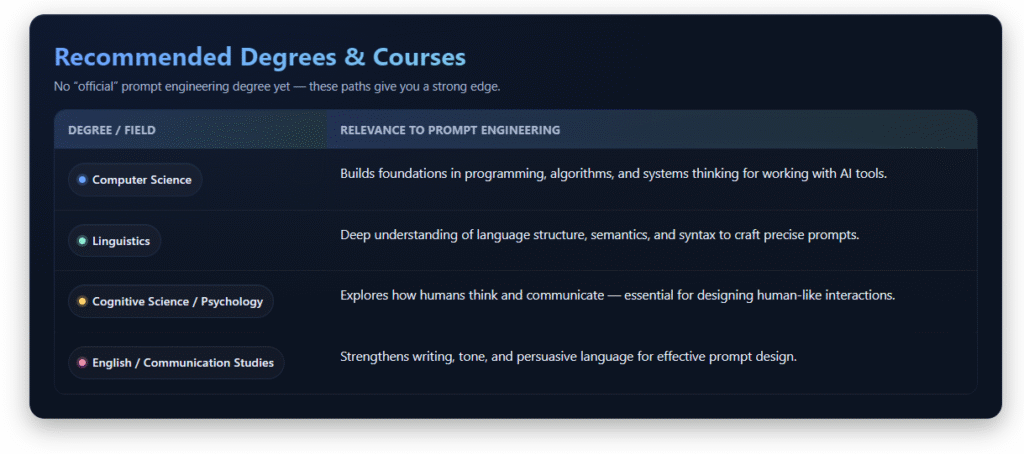
There’s no official degree in prompt engineering-yet. However, certain educational paths can give you a significant advantage. Degrees in the following fields are highly relevant:
- Computer Science: Offers a solid foundation in programming and systems thinking.
- Linguistics: Helps you understand language structure, semantics, and syntax.
- Cognitive Science or Psychology: Teaches you how humans think and communicate-important for crafting effective prompts.
- English or Communication Studies: Enhances your writing, tone, and persuasive language skills.
What matters most is your ability to blend human language understanding with technical curiosity. While you can break into the field without a formal degree, having one of these backgrounds can speed up your learning curve and make you more competitive in job markets.
Also, universities and tech schools are beginning to offer AI literacy programs, which touch on prompt design as part of broader curriculums. Staying ahead by attending such courses can give you an early edge.
Online Certifications and Bootcamps
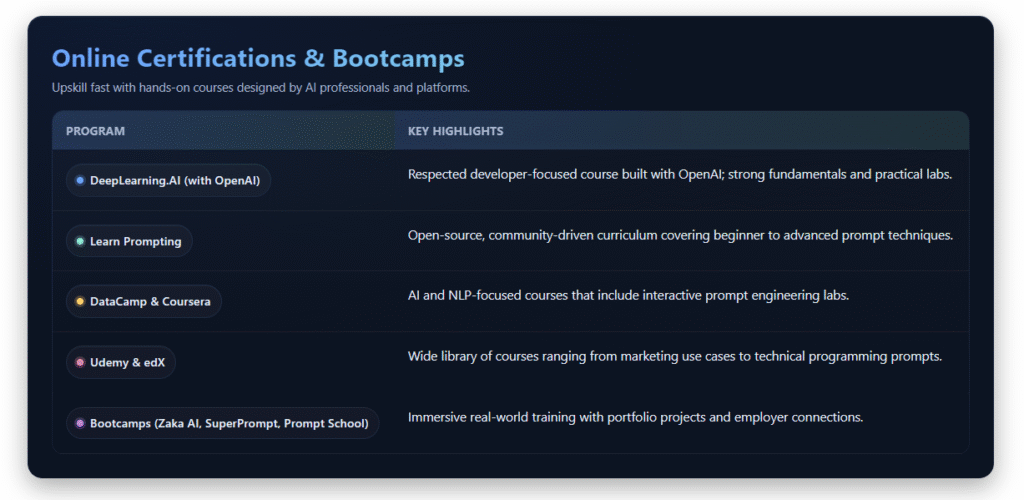
There’s an explosion of online resources teaching prompt engineering, many created by AI professionals and platforms themselves. Here are some recommended programs:
- DeepLearning.AI Prompt Engineering for Developers (via OpenAI): Created in partnership with OpenAI, this course is widely respected.
- Learn Prompting: An open-source, community-built curriculum that covers beginner to advanced techniques.
- DataCamp and Coursera: Offer AI and NLP-focused courses with practical prompt labs.
- Udemy and edX: Have growing libraries of prompt-related content, from marketing to programming.
Bootcamps like Zaka AI, SuperPrompt, and Prompt School focus specifically on real-world prompt applications. Many of them also help you build a portfolio or connect with employers.
While credentials are useful, what really counts is your ability to demonstrate skill. Certifications should support your knowledge-not replace actual hands-on experience.
Self-Learning Resources and Communities
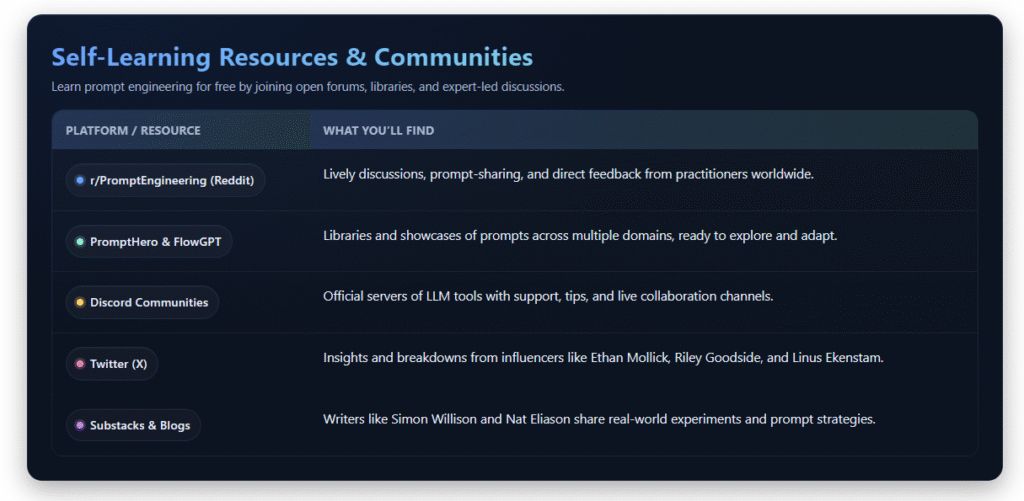
Prompt engineering thrives in open communities. Thanks to forums, blogs, and social networks, you can learn from the best minds in AI without spending a dime.
Some top places to start:
- r/PromptEngineering (Reddit): Lively discussions and prompt-sharing.
- PromptHero and FlowGPT: Prompt libraries and showcases.
- Discord communities: Many LLM tools have official servers with support and tips.
- Twitter (X): Follow influencers like Ethan Mollick, Riley Goodside, and Linus Ekenstam for prompt breakdowns and insights.
- Substacks and Blogs: Writers like Simon Willison and Nat Eliason often share real-world experiments with prompting.
Engaging in these communities accelerates your learning. You’ll see what works, what doesn’t, and how others solve complex prompting problems.
How to Practice and Improve Prompt Engineering Skills
Experimenting with AI Models
The best way to learn prompt engineering? Get your hands dirty.
Start by picking an AI tool like ChatGPT, Claude, or Gemini and begin experimenting. Set mini-goals like:
- Writing a product description
- Creating a summary of a long article
- Generating a customer support response
- Translating casual language into professional tone
Notice how small changes in your input impact the model’s output. Try the same task using different phrasings, tones, or constraints. Create a habit of writing multiple versions of the same prompt and comparing results. This iterative method teaches you what works and why.
Use different models for the same task to see how they vary. For instance, OpenAI’s GPT may be more verbose, while Claude might be more concise. Each model teaches you different lessons.
Also, document your learnings. Keep a prompt journal or GitHub repo where you log what you tried, what worked, and what didn’t. Over time, you’ll build a personal prompt library that becomes a career asset.
Joining Prompt Engineering Challenges
There are now online hackathons and challenges focused exclusively on prompt engineering. These events not only sharpen your skills but also connect you with the community and sometimes even potential employers.
Some popular platforms hosting challenges:
- Zindi or Kaggle (prompt-based competitions)
- FlowGPT Prompt Battles
- PromptBase Challenges
- Hackathons by AI startups or Discord communities
Many challenges offer real-world scenarios, such as creating AI tutors, testing model bias, or improving chatbot tone. Winning (or even participating) in these challenges shows initiative and skill-two things employers love.
If you can’t find a challenge, create your own. Pick a task, set constraints (e.g., only 3 prompt iterations), and test it across models. Share your process publicly-it builds your brand and shows others your problem-solving skills.
Collaborating with Developers and AI Enthusiasts
Prompt engineering sits at the crossroads of writing and development. That’s why collaborating with developers is key. You’ll learn how your prompts can be embedded into larger systems, integrated into apps, or automated through APIs.
Try finding collaborators through:
- GitHub repos in need of prompt contributions
- Discord and Reddit communities
- Hackathons or AI-focused meetups
- Online co-working or pair programming sessions
Working with others helps you understand how your prompts affect product functionality. It also sharpens your ability to explain your prompt decisions clearly-a skill that’s critical during job interviews or client meetings.
Don’t underestimate the power of co-creation. Many of the most successful AI projects are the result of great collaboration between prompt engineers, developers, and designers.
Building a Portfolio as a Prompt Engineer
What to Include in Your Prompt Portfolio
If you want to stand out as a prompt engineer, you need a portfolio. It shows potential employers or clients that you don’t just understand theory-you know how to apply it.
Key items to include:
- Before-and-after prompt examples
- Use-case categories: e.g., summarization, chatbot, email writing
- Model comparisons: e.g., how GPT-4 handled it vs Claude
- Documentation of your thought process: what you tried and why
- Feedback and iterations: show how you improved the output
Use screenshots, structured markdown files, or videos to present your prompts in action. Include any prompt experiments you’ve done as part of challenges, projects, or bootcamps.
How to Showcase Problem-Solving Ability
Great portfolios don’t just show final results-they show how you got there. Employers are interested in your thinking just as much as your output.
For each prompt example, explain:
- What problem you were solving
- What the original prompt looked like
- What the output was, and why it wasn’t ideal
- How you revised the prompt, and what changed
- What you learned from the process
This narrative proves your analytical mindset, creativity, and dedication to results-all of which are key to being a successful prompt engineer.
You can host your portfolio on:
- GitHub
- Notion
- Personal websites or blogs
- LinkedIn articles
- AI-specific platforms like PromptBase or FlowGPT
Landing Your First Job as a Prompt Engineer
Where to Find Prompt Engineering Jobs
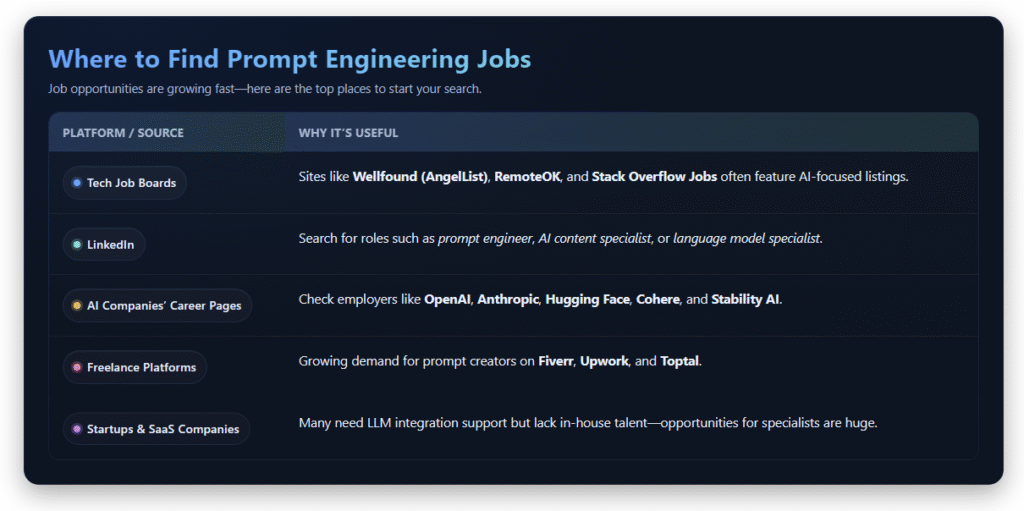
Prompt engineering is a relatively new career path, but job opportunities are growing fast.
Here’s where to begin your search:
- Tech Job Boards: Websites like Wellfound (formerly AngelList), RemoteOK, and Stack Overflow Jobs often feature AI-focused listings.
- LinkedIn: Use search terms like “prompt engineer,” “AI content specialist,” or “language model specialist.”
- AI Companies’ Careers Pages: Check OpenAI, Anthropic, Hugging Face, Cohere, and Stability AI for openings.
- Freelance Platforms: Fiverr, Upwork, and Toptal now have growing demand for AI prompt creators.
- Startups and SaaS companies: Many need LLM integration support but don’t yet have in-house talent.
Many of these roles may not be titled “Prompt Engineer” but could involve tasks like content automation, chatbot scripting, or AI interaction design. Read job descriptions carefully-they often reveal more than the title.
Tailoring Your Resume and Cover Letter
When applying for prompt engineering roles, your resume should emphasize both your language and technical strengths. Here’s how to tailor it:
- Highlight projects where you worked with LLMs like GPT or Claude.
- Showcase your prompt portfolio with links to GitHub or Notion pages.
- Include any bootcamps, certifications, or online courses related to AI.
- Emphasize problem-solving and creative writing experience.
- Add keywords like “prompt optimization,” “natural language understanding,” and “AI interaction design.”
For your cover letter, tell a story. Explain how you discovered prompt engineering, describe a complex problem you solved with a creative prompt, and express your excitement about the future of human-AI collaboration. Personalize it to the company’s mission and tools-they’ll notice the effort.
Interview Preparation Tips
Prompt engineering interviews often include both behavioral and technical assessments.
Here’s how to prepare:
- Prompt Tasks: Be ready to optimize a prompt or troubleshoot poor outputs.
- Live Challenges: You may be asked to write prompts in real time during a Zoom call or via shared document.
- Explain Your Reasoning: Interviewers want to hear your logic. Why did you use that structure? What would you change and why?
- Showcase Creativity and Rigor: Employers value both innovation and disciplined testing.
- Prepare Stories: Talk about situations where you improved an AI response, collaborated with a developer, or dealt with hallucinated outputs.
Practice by solving real-world prompt tasks from websites like PromptBase or by role-playing mock interviews with friends or in online communities.
Career Growth and Opportunities
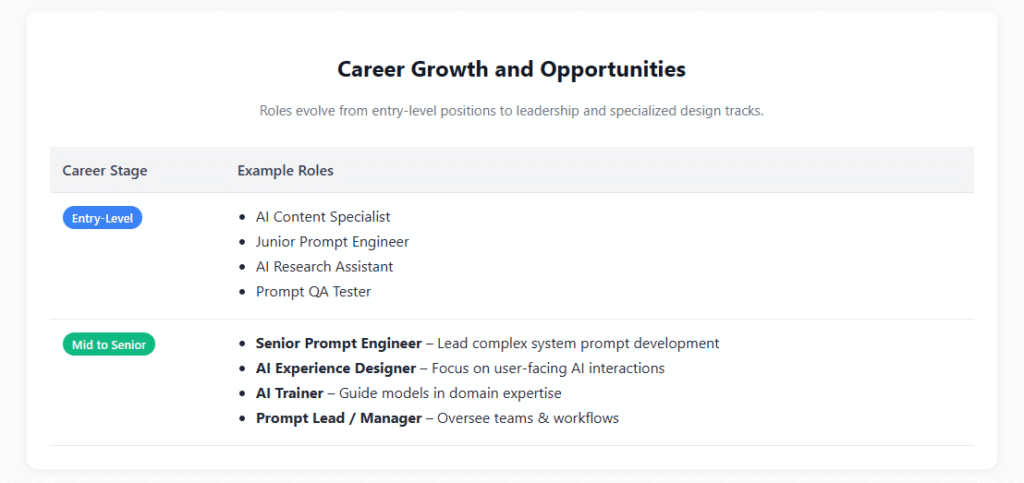
Entry-Level to Senior Roles
As the field of prompt engineering evolves, career paths are becoming more defined.
Entry-level roles often begin as:
- AI Content Specialists
- Junior Prompt Engineers
- AI Research Assistants
- Prompt QA Testers
From there, you can grow into roles like:
- Senior Prompt Engineer: Leading prompt development for complex systems.
- AI Experience Designer: Focusing on user-facing AI interactions.
- AI Trainer: Teaching models how to respond in specific domains.
- Prompt Lead or Manager: Managing a team of engineers and overseeing workflows.
With experience, prompt engineers may transition into AI product management, AI research, or even technical writing for AI systems. The career ladder is still forming, which gives early movers a big advantage.
Transitioning into Specialized AI Roles
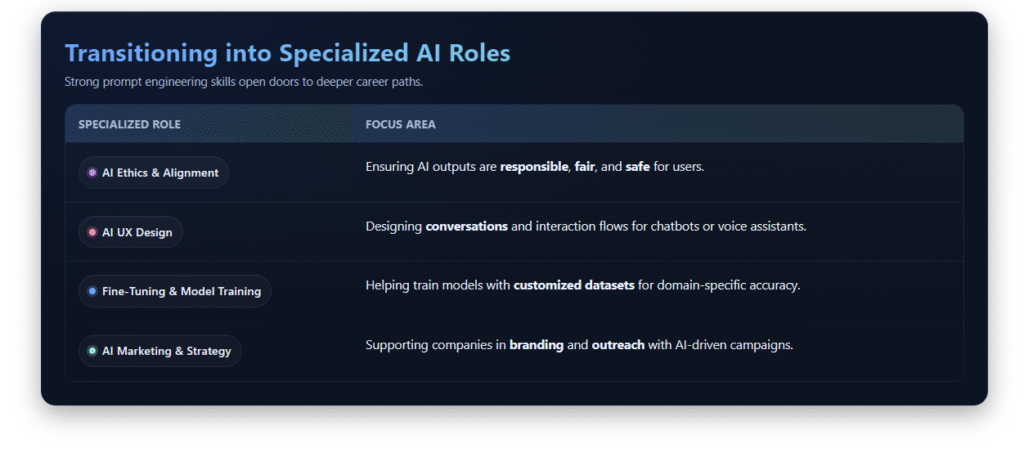
Once you’ve built strong prompt engineering foundations, you might branch into specialized areas like:
- AI Ethics and Alignment: Ensuring AI outputs are responsible and safe.
- AI UX Design: Designing conversations and flows for chatbots or voice assistants.
- Fine-Tuning and Model Training: Helping train models with customized datasets.
- AI Marketing and Strategy: Helping companies integrate AI into their branding and outreach.
Because prompt engineers understand both human language and AI behavior, they’re uniquely positioned to take on hybrid roles that bridge technical and non-technical departments.
Freelancing and Consulting Opportunities
Not all prompt engineers work full-time jobs-many build successful freelance or consulting careers. Businesses that can’t afford in-house AI experts often turn to freelancers for help setting up automations, building prompt templates, or troubleshooting outputs.
To succeed as a freelancer:
- Build a strong personal brand online (LinkedIn, X, blog)
- Offer niche services (e.g., prompt design for e-commerce, law, or healthcare)
- Create sample projects and case studies
- Collect testimonials from clients
- Stay updated with model changes and new tools
As a consultant, you can work with multiple companies, helping them integrate AI into their workflows while charging premium rates for your expertise.
Future of Prompt Engineering
As AI continues to improve, the role of the prompt engineer will also evolve. We’re already seeing the rise of “auto-prompting” tools that help generate prompts automatically. However, that doesn’t mean prompt engineers are going away-it just means the job is changing.
Future prompt engineers may focus more on:
- Designing multi-turn conversation flows
- Working with agents that operate independently
- Creating domain-specific prompt libraries
- Integrating AI into real-time systems (e.g., VR, AR, live customer support)
The best prompt engineers will stay ahead by learning how to work with these evolving tools and understanding not just what prompts to write, but why they work.
Skills That Will Stay in Demand
Regardless of how the tools change, certain skills will always be in demand:
- Sharp language sense and creativity
- Critical thinking and hypothesis testing
- Clear documentation and reproducibility
- Ethical awareness and model safety
- Ability to collaborate across technical and non-technical teams
AI may be evolving fast, but the human ability to understand context, tone, and intent still matters. That’s the magic prompt engineers bring to the table.
Common Mistakes to Avoid in Prompt Engineering
One of the biggest pitfalls in prompt engineering is trying too hard. Some prompt engineers create overly complex or verbose prompts thinking more detail equals better results. Often, it doesn’t. In fact, it can confuse the model or restrict its creativity.
Here’s what to avoid:
- Long, convoluted instructions
- Contradictory directions in a single prompt
- Excessive examples that distract from the core task
Aim for clarity and simplicity first. Once you get a clean base output, then refine it. A minimalist approach often leads to better results, especially when combined with good prompt tuning strategies.
Ignoring Output Evaluation and Feedback Loops
Another major mistake is skipping the feedback loop. Prompt engineering isn’t a one-and-done task. You should continuously evaluate your outputs:
- Are they accurate?
- Are they helpful?
- Do they sound natural?
- Are there any biases?
Too many prompt engineers test a prompt once and move on. Instead, adopt an iterative mindset. Create a mini-feedback system where you test variations, log results, and compare outputs.
Use scorecards, peer reviews, or even end-user feedback to improve your prompts. This process makes your prompts more reliable, scalable, and aligned with business goals.
Real-World Examples of Prompt-Driven Innovation
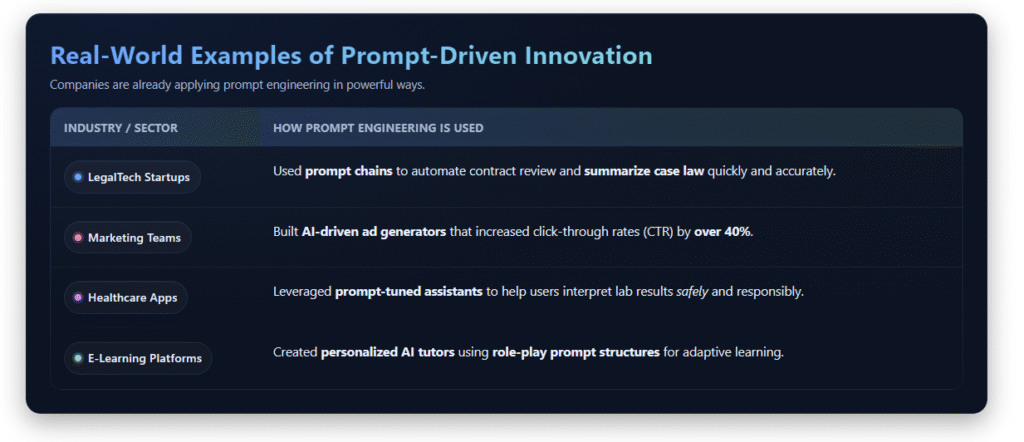
Companies are using prompt engineering in amazing ways. Here are a few highlights:
- LegalTech Startups: Used prompt chains to automate contract review and summarize case law.
- Marketing Teams: Built AI-driven ad generators that improved CTR by over 40%.
- Healthcare Apps: Leveraged prompt-tuned assistants to help users interpret lab results safely.
- E-Learning Platforms: Created personalized AI tutors through role-play prompt structures.
These successes came not from random AI usage, but from deliberate prompt design, testing, and iteration.
Lessons Learned from Industry Leaders
Some best practices from industry leaders include:
- “Start small and iterate quickly.”
- “Log everything-good, bad, weird.”
- “Work closely with users-they’ll show you where prompts fail.”
- “Don’t fear hallucinations-learn from them.”
Prompt engineering is still a Wild West in many ways. The more you test, document, and share, the faster you’ll rise in the ranks.
Communities and Resources to Stay Updated
Top Forums, Newsletters, and Influencers
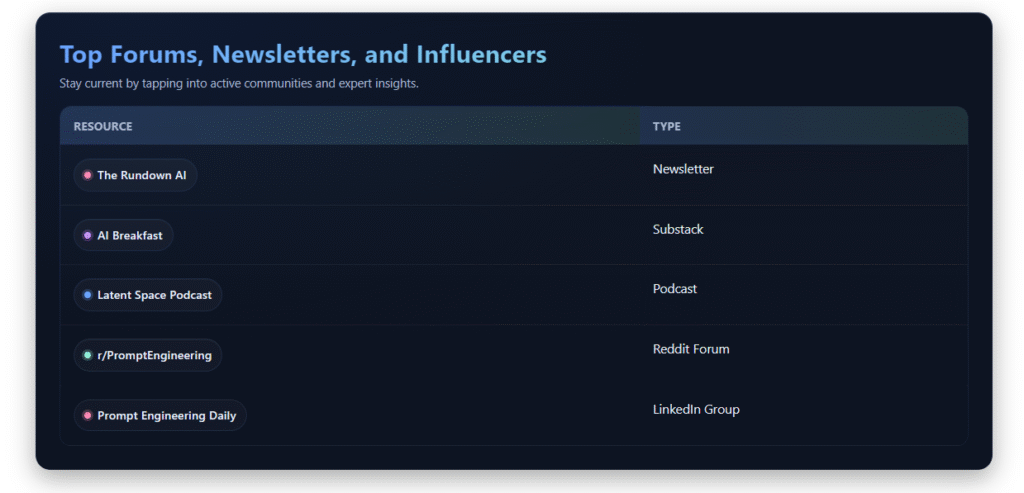
Stay current by tapping into active communities and expert insights. Some must-follow resources:
- The Rundown AI (Newsletter)
- AI Breakfast (Substack)
- Latent Space Podcast
- r/PromptEngineering (Reddit)
- Prompt Engineering Daily (LinkedIn group)
Follow prompt experts like Riley Goodside, Ethan Mollick, Linus Ekenstam, and others on X (Twitter) to get breakdowns of real-world experiments.
Attending Conferences and Webinars
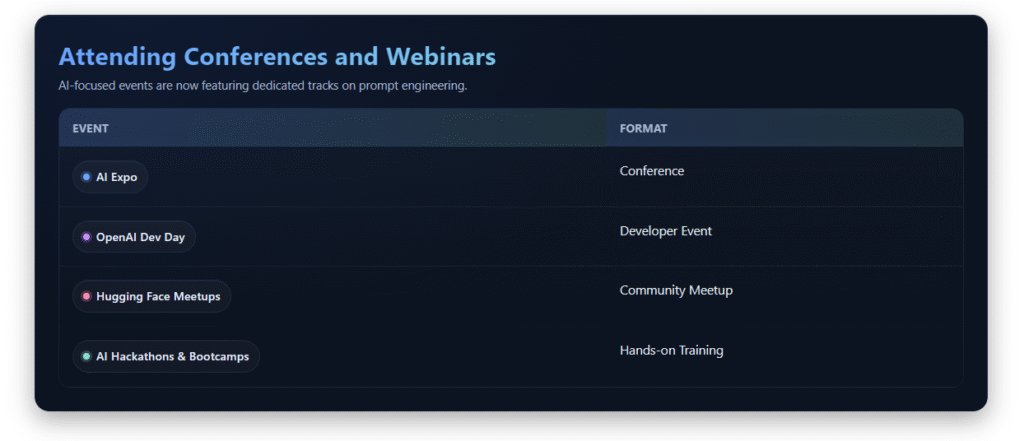
AI-focused conferences are now including prompt engineering tracks. Some worth exploring:
- AI Expo
- OpenAI Dev Day
- Hugging Face Meetups
- AI Hackathons and Bootcamps
These events help you connect with industry peers, get feedback, and discover new tools or techniques you might not find online.
Conclusion
Prompt engineering is one of the most exciting and future-proof careers in today’s tech landscape. It blends the power of language with the precision of code, creativity with logic, and innovation with real-world impact. As AI tools become more integrated into every aspect of life and business, the need for skilled prompt engineers will only grow.
Whether you’re just getting started or already experimenting with LLMs, now is the perfect time to build your skills, create a portfolio, and claim your place in this rapidly expanding field. Stay curious, stay consistent, and never stop testing. The future of prompt engineering is being written-and you can be the author.
FAQs
1. Is prompt engineering a long-term career?
Yes. As AI becomes more widespread, the need for skilled human guidance in prompt design will continue to grow. It’s a foundational skill in the AI economy.
2. Can I become a prompt engineer without coding skills?
Yes, though basic coding helps. If you’re strong in language, writing, and logic, you can succeed without being a developer. However, technical literacy improves job prospects.
3. How much do prompt engineers earn?
Salaries range from $70,000 to over $200,000 per year, depending on experience, role, and company. Freelancers and consultants may earn even more.
4. What are the best tools to start learning prompt engineering?
Start with OpenAI’s Playground, FlowGPT, PromptPerfect, and GitHub. Use ChatGPT or Claude to test your prompts, and track iterations in Notion or Google Docs.
5. How fast can I become job-ready in prompt engineering?
With focused effort, you could become job-ready in 3–6 months by practicing daily, taking online courses, building a portfolio, and joining prompt communities.
